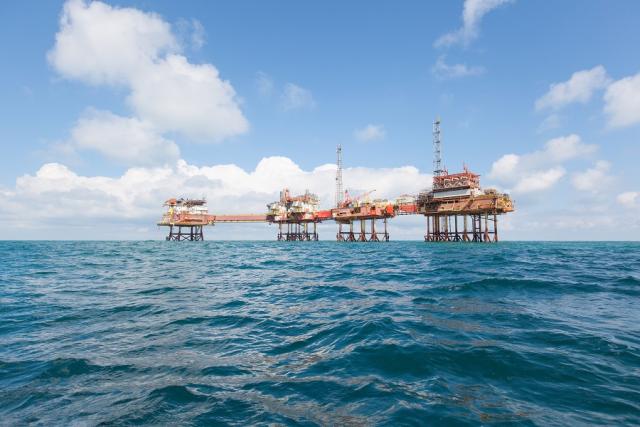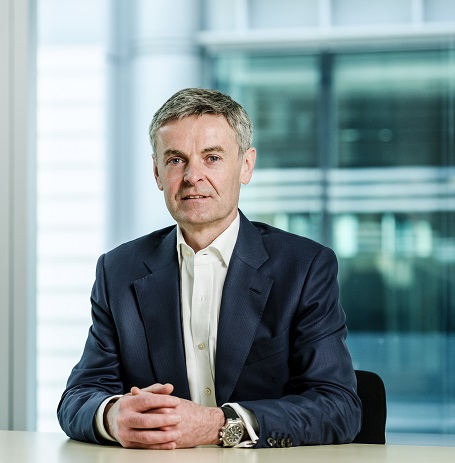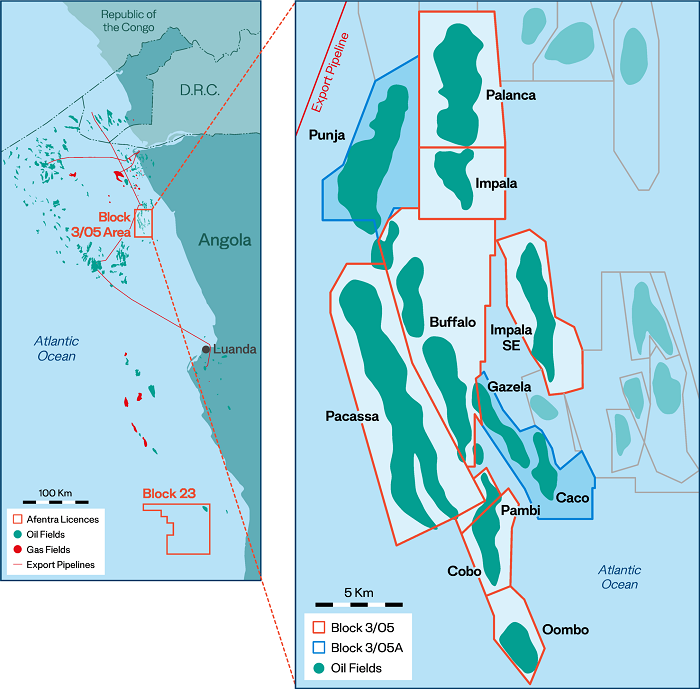
Former Tullow Oil CEO Paul McDade is leading a new company, Afentra, aimed at rejuvenating mature West Africa oil fields. (Source: Shutterstock.com)
Paul McDade has a track record of rejuvenating mature oil projects. Now, he has set its sights on legacy assets offshore West Africa.
The former CEO of Tullow Oil now leads Afentra, a company supported by a number of his former Tullow colleagues, establishing a foothold offshore Angola. Their goal: breathe new life into Blocks 3/05 and 3/05a in the Lower Congo Basin, explore and potentially developing Block 23 in the Kwanza Basin.
Since its founding in May 2021, the company has focused on helping Africa through the energy transition by reducing emissions while increasing oil and gas production.

“A lot of oil there [in Angola] is going to be sold and transitioned over to smaller independents.” — Paul McDade, Afentra.
McDade, the CEO and co-founder of Afentra, spent much of his career buying brownfield assets in the North Sea from supermajors and rejuvenating them to extend their productive lifespans. West Africa is ripe for the same type of activity, he said, because the region’s oil industry transition has only been in progress for the past couple of years.
“It’s about 15 or 20 years behind where the North Sea is,” he said.
West Africa’s oil industrial transition paired with the global energy transition was a “huge” business opportunity that McDade, his co-founders and backers couldn’t pass up. They named the company Afentra as a nod to both Africa and the energy transition.
Because the energy transition will take time and oil and gas will continue to make up a large portion of the energy mix for a while, McDade said it’s critical that hydrocarbons be produced responsibly and for companies to be transparent about the management of assets.
But even more critical, McDade said, is that any company operating in West Africa needs to generate a positive social impact.
“Can you run a well-governed business in West Africa? Our answer is that absolutely you can,” he said.
The company is focusing on existing assets with relatively high emissions.
“We see lots of opportunities to reduce those emissions. If you go into a gas project with a low emissions footprint, there’s not much you can do to improve it,” he said. “But some of these older assets in West Africa, we see a lot of opportunity to create value, and in the creation of the value, reducing the emissions as well.”
Overall, he said, “there’s a lot more I can do with high-emission assets. It makes a delta impact.”
Angola angle
In order to expand, Afentra picked up “quite a bit of debt capacity” in the market, McDade said. Its first two deals were for blocks offshore Angola, which he called the company’s key strategic target, but Afentra is also screening other assets along the West African coastline. One of the Angolan deals received government approval while the other was pending government approval as of mid-January.

“I know Angola reasonably well,” he said, noting it has historically been the domain of integrated oil companies. Afentra’s reception in Angola was “very welcoming. They paid a lot of attention to Afentra, despite our size.”
One reason smaller companies are being welcomed, he said, is because the larger companies are migrating away from the shallow water where mature assets are “at the end of their lives for IOCs [integrated oil companies], and they are happy to sell them on to smaller companies.”
The government is encouraging smaller independent companies to redevelop these assets to extend their productive lives by extending existing licenses and improving fiscal terms, he said.
Currently, he said, Angolan waters hold about 15 Bbbl of discovered but not developed resources.
“A lot of oil there is going to be sold and transitioned over to smaller independents,” McDade said.
In April 2022, Afentra signed an agreement with Sonangol for interest in the blocks and later followed that up with a deal from Industrija Nafte (INA). Both transactions are awaiting government approval.
Block 23 includes a working petroleum system and contains a small pre-oil discovery. Afentra, which purchased its 40% stake in the block from Sonangol, said 95% of the basin is underexplored, with the potential to be derisked using advanced geophysics.
Block 23 contains the 2012 Azul oil discovery, which is the first deepwater pre-salt find in the Kwanza Basin.
The other two blocks have more immediate possibilities.
Generally speaking, Afentra aims to become the operator of producing assets and would be “delighted to replace a company as operator” but is willing to enter an asset as a joint venture partner if the operator intends to farm out after a few years.
Afentra is entering the Sonangol-operated Blocks 3/05 and 3/05a as a partner.
“They were looking for a partner to bring experience from other areas and bring a mature field operator to the table in an active way,” McDade said. “We don’t want to be a passive partner.”
Block 3/05
As an active partner in Block 3/05, one of the main expectations is that Afentra will help Sonangol “squeeze the asset,” which is currently producing about 19,000 bbl/d from infrastructure covering eight fields. The block’s fields, discovered between 1981 and 1992, are Palanca, Pacassa, Buffalo, Cobo, Pambi, Oombo, Impala and Impala SE.
There’s about 3 Bbbl of light sweet oil initially in place (OIIP) in the shallow water block. Breakeven here would be about $35/bbl, and every 1% increase in recovery from the OIIP of 3 Bbbl translates to 30 MMbbl of additional production, according to Afentra.
“It’s a mature asset with a long life ahead of it,” McDade said. “There’s lots of opportunities for workovers, the usual things you do for a mature asset.”
Afentra said it has a wish list of ways to improve production and reduce emissions here.
Sonangol operates the asset with 30% after selling 20% to Afentra. Afentra also bought 4% interest from minority partner INA, making Afentra the second largest interest holder in the block with 24%. Sonangol took over operatorship of the block when Total exited the asset in a phased handover from 2005 to 2013.
“They have been doing a good job of maintaining the asset, but they haven’t been squeezing the asset,” he said.
While there are 100 wells in the block, “only half of those wells are active at the moment,” McDade said. “There’s lots of opportunity to go in and redevelop those assets.”
The initial aim is to boost current production of 19,000 bbl/d to over 20,000 bbl/d, he said, but “I think we can increase it to 30,000 barrels a day.”
First off the bat will be resuming water injection to increase production, he said, since there “hasn’t been a lot of water injection going on.”
Some of the inactive wells may resume production with the water injection due to increasing reservoir pressure, McDade said.
There are also plans to re-enter some of the inactive wells with a light workover rig, as well as plans to test how wells perform with electrical submersible pumps.
“We’ll move over to that if it works,” he said.
No infill drilling has been carried out in about 15 years, he said, so identifying potential locations for those wells is also on the to-do list.
Block 3/05a
Block 3/05A is adjacent to Block 3/05, and Afentra acquired 5.3% interest in the block from INA.
The shallow water block operated by Sonangol has three discoveries. Block 3/05a’s three fields were discovered in 1982, 1986 and 1990, but initial production didn’t follow until 2015. The fields are Punja, Caco and Gazela, which hold about 300 MMbbl in place.
“After we do infill drilling in the main area, we can start to think about developing these assets and tying them back to infrastructure,” he said. “There’s a long list of things we’re looking at in the five-year plan.”
Recommended Reading
Crescent to Offer $750MM in Senior Notes to Settle SilverBow Debt
2024-06-13 - Crescent Energy intends to use the proceeds to fund the cash portion of its merger with SilverBow Resources and to repay SilverBow’s outstanding debt at the time of the transaction’s closing.
Permian Resources Announces Financing Moves Following Oxy Deal
2024-07-29 - Permian Resources’ will offer cash for its senior notes Due 2026, among other financing moves, following a July 29 agreement to buy Delaware Basin assets from Occidental Petroleum for $817.5 million.
Kinetik Closes Acquisition of Durango’s New Mexico Delaware G&P Assets
2024-06-25 - Kinetik Holdings closed a $765 million acquisition of Durango Permian LLC, deepening Kinetik’s footprint of gas gathering and processing assets in the Delaware Basin.
Newly Public LandBridge Closes Three Surface Acquisitions
2024-08-08 - LandBridge’s acquisitions in second-quarter 2024 bring its total Permian Basin surface position to approximately 220,000 acres.
Vista CEO: Bidding for Exxon’s Vaca Muerta Assets ‘Very Competitive’
2024-07-15 - Vista Energy, one of the largest producers in Argentina’s Vaca Muerta shale field, aims to get bigger through Exxon Mobil assets reportedly being shopped for $1 billion.






